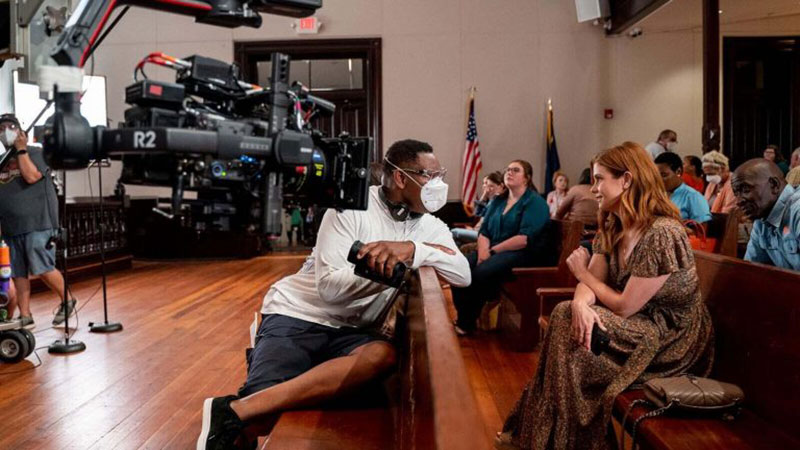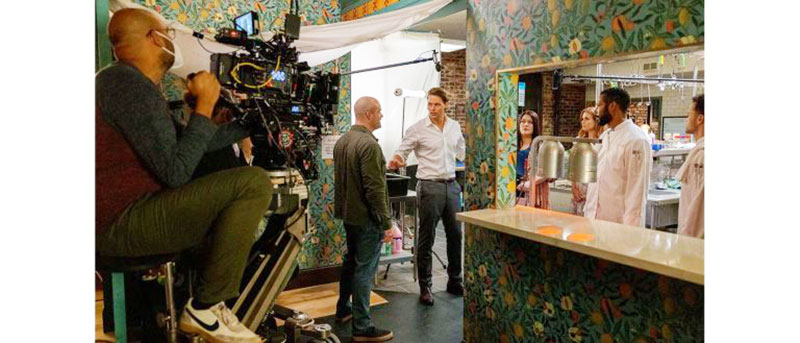Netflix’s ‘Sweet Magnolias’ Season 2 was shot on the Sony VENICE. The production’s on-set monitoring workflow supported real-time SDR/HDR monitoring using Sony 4K HDR monitors.

Netflix’s ‘Sweet Magnolias’ is a romantic drama set in the American South. The series’ three main characters are lifelong friends, living through their lives alongside each other, sharing successes, failures and dreams. The project was shot on the Sony VENICE full-frame digital cinema camera in HDR format.
After Season 1 of 'Sweet Magnolias' gained a following, Netflix released Season 2 on 4 February 2022. The storyline of each character helped the production set the tone and look of the show, which shifted between traditional bright exteriors typical of romances and darker shadowy elements, using the dynamic range of the footage to emphasise the contrast.
SDR and Dolby Vision HDR Delivery
Tyler Blackwell worked as Digital Imaging Technician (DIT) on the project with Brian Johnson as Director of Photography. Tyler’s role was to work with Brian, who was using the VENICE for the first time, to understand his vision in technical terms and maintain it accurately throughout production and into post.
Tyler worked on set with a combination of Sony PVM-X2400 and BVM-HX310 4K HDR monitors. He said, “On 'Sweet Magnolias', we’re delivering a show in SDR and HDR. My eyes need to be on every frame and having HDR monitoring on-set has been very helpful in pushing a different, standardised look. We used Dolby Vision, which I think is the HDR format that produces the best viewing experience for audiences.”
He said, “After some trial and error using other equipment, and working through some R&D, I found my way to the Sony 4K HDR monitors. On Sweet Magnolias, we use three PVM-X2400s on my cart and the main cart, and one BVM-HX310 on the HDR cart, which is in our command centre – the DIT tent.” Monitoring in the DIT tent is set up to generate the best visual representation possible of the final look of the film.
The BVM-HX310 is also used to QC dailies material. “We use the BVM-HX310 to make sure the team is comparing my stills to what they’re viewing in their environment and ensure everything is aligned to what Brian and I have created.”

Dynamic Contrast
Tyler has been using the Sony PVM-X2400 since standardising on the BVM-HX310 in 2020. He likes the monitors’ dynamic contrast drive feature, a backlight control system that helps ensure content is matching to the HX310. Dynamic Contrast Drive adjusts the panel’s backlight luminance to adapt to changing content. It helps users confirm the total balance of highlights and low lights at a glance. With a dynamic contrast ratio of 1,000,000:1, it can be used to reproduce how blacks are represented in dark night time content, for example, and show specular highlights in bright content such as scenes in snow or bright sunlight.
Tyler already owns two BVM-HX310s, and finds certain advantage in working with a primarily Sony workflow. He said, “The fact that the HX310 and X2400 are an extremely colour accurate match and work well together is very important. Once, when Brian and the crew were shooting on the rooftop of a building, we decided to bring the HX310 up with the crew so that Brian could view what was being shot in real time. Because of the size and the weight of my cart, and having no elevator in the facility, rolling my cart in wasn’t an option.
“I was three floors down, operating the cart and relaying images between Brian and myself, so that he could match the images he was looking at on set with what he wanted to see in the final image. I had one of the X2400 monitors in HDR mode and the other in SDR mode. Brian was upstairs monitoring in SDR on the HX310 but I was able to maintain the same environment that we normally have, where the HX310 is displaying HDR and the X2400 are in SDR mode on the cart.”
Using HDR Insight
Accommodating an HDR viewing environment is important to Brian as well, despite the understanding that he’ll primarily be viewing content on the SDR monitors and many of the show’s viewers will be watching ‘Sweet Magnolias’ in SDR as well. He realises there are certain situations where having an HDR vantage point helps anticipate and control the viewing experience.
“In scenarios with a wider field of view or multiple windows looking out, we’ll put that up on the HDR monitor to see the perceptual effect of the bright windows,” he said. “Even if they’re not clipping, in HDR they can be extremely bright which gives us perceptual information beyond any waveform information and means we can adapt our strategy to mitigate the brightness. When looking at an SDR image, you don’t always have that same insight.
“We’ve found it reassuring and convenient to be able to monitor in HDR on-set, particularly when we’re getting close to a place that we feel good about the lighting in SDR. Once I check the HDR monitor, we can bring the highlights down more, if needed, or flag elements to address in post. Of course, using the monitors shows me whether or not I’m in a good place with the HDR deliverable as well, which is invaluable.”

Tyler also likes the monitors’ multiple channel setups. “I haven’t had a chance to use all 30, but to be able to quickly move through different configurations on the monitor is fantastic,” he said. “Then I use the quadrant view to set an HDR and SDR next to each other.”
A Real Cinema Camera
Brian initially chose the VENICE due to its ability to meet Netflix’s delivery requirements and its large format sensor, which allowed him to capture Sweet Magnolias in 16:9 at 5.7K. He was pleased with its representation of contrast and colour, and other characteristics suited him and the production as well.
“Since I knew that on this project, we would want to limit the depth of field as much as possible on stage, I was really keen to go with a large format sensor. It worked out that the VENICE was the best candidate, and it aligned with our budget. I had read a lot about the VENICE and had colleagues who had shot on it and had great experiences, and so I was curious and excited to work with VENICE. It’s proven to be an awesome camera – this won’t be the last time I use it.
“This is a real cinema camera. My team changes the ISO a lot, from bright scenes to dark, and we love the internal ND function, which we use constantly. All of the functions are right there for the assistants. Also, the camera is small and light enough that we’ve built it on the Ronin very successfully, which has been a great combination.” The production also used Sony’s SxS cards to set up dual recording, recording to AXS and SxS media simultaneously as a backup.
More Colour, More Information
From the point of view of a DIT, Tyler said, “To be able to work with a piece of equipment that can see more colour than the human eye is pretty inspiring. To know that we have as much as what we can perceive on set to work with is incredible. In addition, from a technical perspective, the ISOs we’re using are a way to make sure that we’re maintaining shadows or maintaining highlights, depending on the scene, and the lighting environment that we’re in.”
Tyler likes using Sony's custom .art (ART) files, which are able to achieve bit-level accuracy when working with a 3D LUT on-set for monitoring, and improve image integrity for critical viewing applications. Specifically, for on-set monitoring, the Technicolor Look Collection of LUTs for VENICE includes Sony’s new proprietary file format .art. ART files use VENICE's internal processing to improve the quality of on-set monitoring.

Tyler has found that ART extensions visualise the information for the camera operators and assistants, when he can’t be on-set personally due to COVID restrictions. “Being able to leave Brian and the department with a camera that’s outputting the show LUT in an ART was critical for Brian to be able to continue with his work without someone like me there, keeping an eye on things.”
Moving Forward
In an immediate sense, Sony VENICE was chosen for its look, workflow and level of real-time control it gave the production over the colour to enhance this show’s story. But both Brian and Tyler also believe that using top level production equipment, like the HDR monitors and VENICE camera, to produce a mainstream TV series is a way of moving their industry forward – specifically, toward a future when HDR expectated – while extending the show’s longevity.
Brian said, “I can only assume that one day, all monitors will be HDR, and keeping an eye toward that, we can increase the shelf life of Sweet Magnolia’ by using equipment that can handle the highest dynamic range achievable right now.” pro.sony




